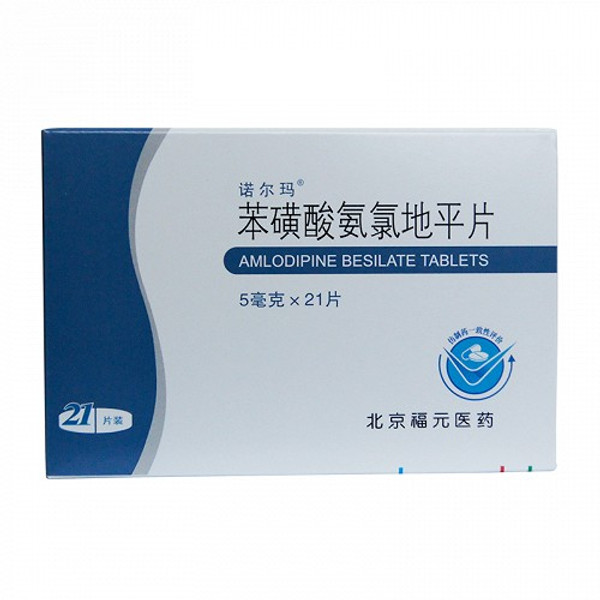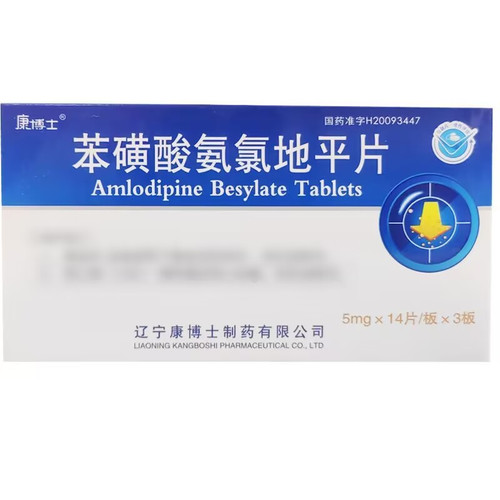Product Overview
[Drug Name]
Generic Name: Amlodipine Besylate Tablets
Trade Name: Norma Amlodipine Besylate Tablets 5mg*21 Tablets
Pinyin Full Code: NuoErMa BenHuangSuanAnLvDiPingPian 5mg*21Li
[Main Ingredients]
The main ingredient of this product is amlodipine besylate.
[Properties]
This product is a white tablet.
[Indications/Main Functions]
(1) Hypertension (used alone or in combination with other drugs).
(2) Angina pectoris: especially spontaneous angina pectoris (used alone or in combination with other drugs).
[Precautions]
1. Warning: A very small number of patients, especially those with severe coronary artery obstructive disease, experience increased frequency, prolonged duration and/or worsening of angina pectoris, or acute myocardial infarction when starting treatment with calcium antagonists or increasing the dose. The mechanism of action is currently unclear. 2. Because amlodipine's vasodilatory effect develops gradually, rare cases of acute hypotension have been reported following its use. However, caution should be exercised when used in combination with other peripheral vasodilators in patients with severe aortic stenosis. 3. Use in Patients with Heart Failure: Calcium channel blockers should be used with caution in patients with congestive heart failure. In a long-term, placebo-controlled study (PRAISE-2) of patients with non-ischemic heart failure (NYHA class III-IV), although the incidence of heart failure exacerbations was not significantly different compared with placebo, there was an increase in reports of amlodipine-related pulmonary edema. 4. Use in Patients with Impaired Hepatic Function: As with all calcium channel blockers, the half-life of amlodipine is prolonged in patients with impaired hepatic function, but a recommended dose has not yet been established. Therefore, this product should be used with caution. 5. Use in Patients with Renal Failure: Changes in amlodipine plasma concentrations are not correlated with the degree of renal impairment; therefore, a normal dose can be used. This product is not dialyzable.
[Drug Interactions]
This product is contraindicated in patients with hypersensitivity to dihydropyridine calcium channel blockers or any of its components.
[Pediatric Use]
The recommended dose of this product for hypertensive children aged 6 to 17 years is 2.5 mg to 5 mg once daily. No studies have been conducted in pediatric patients using doses exceeding 5 mg daily.
[Geriatric Use]
No clinical studies have been conducted to determine whether elderly patients (over 65 years) respond differently to this product than younger patients. Other clinical studies have not demonstrated differences in responses between elderly and younger patients. In general, given that elderly patients are often more likely to have impaired liver, kidney, or cardiac function and to have concurrent illnesses or to be taking other medications, dose selection should be cautious in elderly patients, generally starting with a lower dose within the recommended dose range. Elderly patients have decreased clearance of this product, resulting in an approximately 40-60% increase in the area under the curve (AUC), so a lower starting dose is recommended.
[Pregnancy and Lactation Use]
Adequate and well-controlled studies have not been conducted in pregnant women. Amlodipine should be used during pregnancy only if the potential benefit outweighs the potential risk to the fetus. No teratogenicity or other embryo/fetal toxicity was observed in pregnant rats and rabbits receiving oral doses of amlodipine maleate up to 10 mg amlodipine/kg/day (8 times and 23 times the maximum recommended human dose of 10 mg, respectively, on a mg/m² basis [based on a 50 kg patient weight]) during their respective periods of major organogenesis. However, a significant decrease in litter size (approximately 50%) and a significant increase in intrauterine mortality (approximately 5-fold) were observed in rats treated with amlodipine maleate (equivalent to 10 mg amlodipine/kg/day) for 14 days prior to mating, throughout mating, and during pregnancy. Studies have shown that amlodipine maleate at this dose can prolong the duration of pregnancy and parturition in rats.
[Specifications]
5mg*21 tablets
[Dosage and Administration]
The typical starting dose for treating hypertension is 5mg once daily, with a maximum dose of 10mg once daily. For patients of small stature, frailty, the elderly, or those with hepatic insufficiency, the starting dose is 2.5mg once daily; this dose can also be used in combination with other antihypertensive medications.
[Adverse Reactions]
This drug is well tolerated within the 10mg/day dose range, with most adverse reactions being mild to moderate. Discontinuation rates due to adverse reactions were only 1.5%, which was not significantly different from placebo (approximately 1%). The most common adverse reactions were headache and edema. Dose-related adverse reactions with an incidence greater than 1% were as follows: edema, dizziness, hot flashes, and palpitations. Adverse reactions with unclear dose relationships but an incidence greater than 1.0% were as follows: headache, fatigue, nausea, abdominal pain, and somnolence. Among these adverse reactions, edema, hot flashes, palpitations, and somnolence were more common in women than in men. The following adverse events occurred in ≥ 1% but > 0.1% of patients, and a causal relationship to the drug was unclear: General: allergic reaction, asthenia, back pain, hot flashes, malaise, pain, stiffness, weight gain; Cardiovascular: arrhythmia (including tachycardia, bradycardia, or atrial fibrillation), chest pain, hypotension, peripheral ischemia, syncope, postural dizziness, orthostatic hypotension, and vasculitis; Central and Peripheral Nervous System: hypoesthesia, peripheral neuropathy, paresthesia, tremor, vertigo; Gastrointestinal: anorexia, constipation, dyspepsia, dysphagia, diarrhea, flatulence, pancreatitis, vomiting , gingival hyperplasia; musculoskeletal system: joint pain, arthritis, muscle cramps, myalgia; mental: sexual dysfunction, insomnia, tension, depression, nightmares, anxiety, depersonalization; skin and appendages: angioedema, erythema, pruritus, rash, maculopapular rash; special senses: visual abnormalities, conjunctivitis, diplopia, eye pain, tinnitus; urinary system: frequent urination, urination disorder, nocturia; autonomic nervous system: dry mouth, night sweats; metabolism and nutrition: hyperglycemia, thirst; hematopoietic system: leukopenia, purpura, thrombocytopenia. The incidence of the following adverse events is 0.1%: heart failure, irregular pulse, extrasystoles, skin discoloration, urticaria, dry skin, dermatitis, alopecia, muscle weakness, twitching, ataxia, hypertonia, migraine, cold and clammy skin, apathy, agitation, amnesia, gastritis, increased appetite, loose stools, cough, rhinitis, dysuria, polyuria, parosmia, taste disturbances, visual accommodation disturbances, and xerophthalmia. Other rare reactions, such as myocardial infarction and angina, cannot be distinguished as drug effects or disease states. Routine laboratory tests were unremarkable, with no significant changes in serum potassium, blood glucose, triglycerides, total cholesterol, high-density lipoprotein (HDL), uric acid, blood urea nitrogen, or creatinine. Post-marketing, there have been occasional reports of gynecomastia in patients taking the drug, but a causal relationship to the drug is unclear. In some cases, jaundice and elevated liver enzymes (often associated with cholestasis and hepatitis) have been severe, requiring hospitalization.
Contraindications:
This product is contraindicated in patients with hypersensitivity to dihydropyridine calcium antagonists or any of its ingredients.
Overdose:
Severe overdose may cause excessive peripheral vasodilation, accompanied by significant hypotension and reflex tachycardia.
Pharmacology and Toxicology:
Amlodipine is a dihydropyridine calcium antagonist (also known as a calcium ion antagonist or slow-channel blocker) that inhibits the transmembrane influx of calcium ions into vascular smooth muscle and myocardium. Experimental data indicate that amlodipine binds to both dihydropyridine and non-dihydropyridine binding sites. The contraction of myocardial and vascular smooth muscle depends on the influx of extracellular calcium ions into the cell through ion channels. Amlodipine selectively inhibits transmembrane calcium transport, with a stronger effect on vascular smooth muscle cells than on myocardial cells. Negative inotropic effects have been observed in vitro, but these effects have not been observed in live animals at therapeutic doses. Amlodipine does not affect serum calcium concentrations. Within the physiological pH range, amlodipine is an ionized complex (pKa = 8.6) that achieves its gradual onset of action by slowly binding to and dissociating from calcium channel receptors at their binding sites.
[Pharmacokinetics]
After oral administration of a therapeutic dose of amlodipine, peak plasma concentrations are reached 6 to 12 hours later. Absolute bioavailability is approximately 64 to 90%, and amlodipine's bioavailability is unaffected by food intake. Amlodipine is extensively metabolized (approximately 90%) by the liver to inactive metabolites, with the remaining 10% excreted as parent drug and 60% of metabolites excreted in the urine. In vitro studies have shown that plasma protein binding is approximately 93% in hypertensive patients. Its plasma clearance is biphasic, with a terminal elimination half-life of approximately 35 to 50 hours. Steady-state plasma concentrations of amlodipine are achieved after 7 to 8 days of continuous daily dosing. The pharmacokinetics of amlodipine are not affected by renal impairment. Therefore, patients with renal failure should still receive the usual initial dose. In elderly patients and those with impaired liver function, amlodipine clearance is slowed, resulting in an approximately 40-60% increase in the area under the curve (AUC), necessitating a lower starting dose. Similar increases in AUC have been observed in patients with moderate to severe heart failure. In 62 hypertensive pediatric patients aged 6 to 17 years, amlodipine 1.25 mg to 20 mg was administered. Weight-adjusted clearance and volume of distribution were similar to those in adults.








